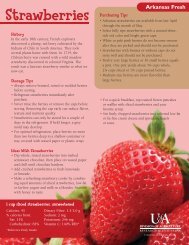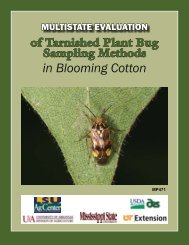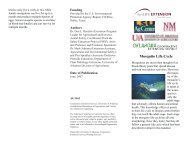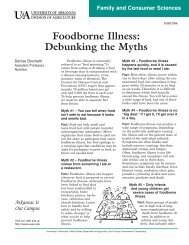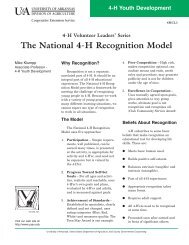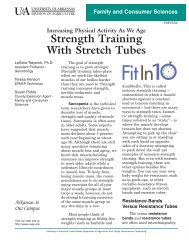Evergreen Hedge Or Screen Plants - University of Arkansas ...
Evergreen Hedge Or Screen Plants - University of Arkansas ...
Evergreen Hedge Or Screen Plants - University of Arkansas ...
You also want an ePaper? Increase the reach of your titles
YUMPU automatically turns print PDFs into web optimized ePapers that Google loves.
Cupressus arizonica – Arizona Cypress<br />
This appears to be an excellent screen plant for full sun locations. While needle color on the species is a<br />
gray‐green, most cultivars have an eye‐catching silver‐blue/powder‐blue color. The blue hue is even better<br />
than what you get with the blue atlas cedar (Cedrus atlantica ‘Glauca’). Some <strong>of</strong> the blue foliage forms<br />
include ‘Blue Ice,’ ‘Blue Pyramid,’ ‘Carolina Sapphire,’ ‘Cook’s Peak’ and ‘Silver Smoke.’ ‘Blue Ice’ and ‘Blue<br />
Pyramid’ may have a much tighter pyramidal habit than ‘Carolina Sapphire.’ ‘Carolina Sapphire’ is a popular<br />
cut Christmas tree in <strong>Arkansas</strong>. This needle‐like evergreen grows faster than Leyland cypress. In general,<br />
the plant is free <strong>of</strong> serious insect and disease problems. Bagworms will be more common on ‘Carolina<br />
Sapphire’ than ‘Blue Ice.’<br />
The growth habit <strong>of</strong> young plants is very similar to our native eastern<br />
redcedar (Juniperus virginiana). Because needles are not borne in flat<br />
sprays like Leyland cypress, the overall texture is very s<strong>of</strong>t. <strong>Plants</strong> are<br />
clearly taller than they are wide and pyramidal in shape. As the plant<br />
matures, it will open up. Very old specimens almost have a weeping, graceful<br />
pyramidal appearance. Arizona cypress thrives on full sun in exposed<br />
situations. While<br />
constant moisture<br />
might promote<br />
growth, an established<br />
plant should<br />
tolerate fairly dry<br />
conditions. Avoid<br />
wet spots.<br />
‘Blue Ice’ <br />
Arizona cypress<br />
Cupressus sempervirens ‘Stricta’ – Italian Cypress<br />
While not that common in <strong>Arkansas</strong>, the extremely columnar<br />
growth habit makes this plant easy to identify in the landscape.<br />
The Italian cypress is likely best suited to central and<br />
southern <strong>Arkansas</strong>.<br />
Italian cypress<br />
19









